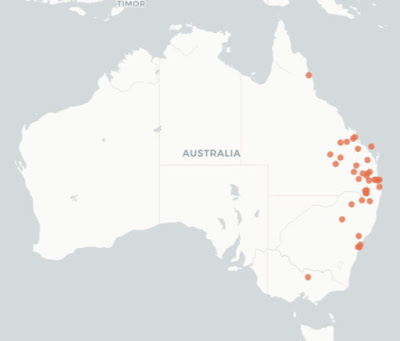Early one morning last week, I was wandering up my street
(bird watching) and noticed a group of Sulphur-crested Cockatoos on the road
under a large eucalyptus tree. They were clearly feeding on something on the
ground. Closer inspection revealed their interest was in Christmas beetles.
There were ten cockatoos on the ground, a further three in the outer foliage of
the tree and a couple more on prominent perches nearby (possibly sentinels?).
The birds on the ground were feasting on fallen beetles –
some alive and still crawling, many barely alive, and many more quite dead. The
birds in the tree were clambering about the outer foliage deliberately seeking
out and ‘plucking’ the beetles feeding on the fresh young foliage.
In both situations, the cockatoos manipulated the beetles, using both beak and feet, in the same way they would an equivalent-sized fruit, or acorn; the softer inner parts of the beetle being scooped out and eaten before the exoskeletal husk was unceremoniously dropped, adding to the carnage below. From the remnants, it appears the muscle tissue inside the thorax was possibly the main attraction.
In both situations, the cockatoos manipulated the beetles, using both beak and feet, in the same way they would an equivalent-sized fruit, or acorn; the softer inner parts of the beetle being scooped out and eaten before the exoskeletal husk was unceremoniously dropped, adding to the carnage below. From the remnants, it appears the muscle tissue inside the thorax was possibly the main attraction.
The following morning, a slightly smaller group of cockies
again arrived on the scene and began helping themselves to the dwindling supply of
beetles. They seemed a little less engaged, or a little more distracted, and were
soon dispersed when a small dog showed up. Some of the cockatoos moved off down
the street to feed on the under-ripe fruit of a flowing plum tree for desert.
My interest and surprise in these events was twofold.
Firstly, the sheer number of Christmas beetles was impressive, particularly in times when the incidence of these beetles seems to be reducing year by year. I estimated at least several hundred beetles on the ground, and many more were visible in the foliage. As far as I could discern, all were Anoplognathus chloropyrus, the Green-tailed Christmas Beetle, even though several different species of Christmas beetles occur in Canberra.
Firstly, the sheer number of Christmas beetles was impressive, particularly in times when the incidence of these beetles seems to be reducing year by year. I estimated at least several hundred beetles on the ground, and many more were visible in the foliage. As far as I could discern, all were Anoplognathus chloropyrus, the Green-tailed Christmas Beetle, even though several different species of Christmas beetles occur in Canberra.
Secondly, animal material is a rare component of the diet of
Sulphur-crested Cockatoos. HANZAB (Handbook of Australian, New Zealand and Antarctic Birds - the
Australian ornithologist’s ‘bible’) and another authoritative book on
Australian parrots mention a few instances of insect material being consumed,
including the larvae of longhorn beetles from dead trees, and the larvae and/or
eggs of Diptera (fly larvae), Hymenoptera (ant eggs) and Orthoptera
(grasshopper larvae and eggs). Christmas beetles are not mentioned. Indeed
there is no mention of adult forms of any kind of insect being eaten, let alone
such large, crunchy, heavily sclerotized ones as Christmas beetles (not that this would be an issue
for the cockies’ massive bills).
When available, Christmas beetles are readily eaten by a
range of other birds in the area, including the Australian Ravens that breed each year in the tree in
question, Pied Currawongs, Australian Magpies, Noisy Friarbirds, Dollarbirds and so on. But
this appears to be the first instance, at least that I am aware of, of
Sulphur-crested Cockatoos exploiting this food resource. It seems this might be
quite an unusual occurrence, and quite possibly related to the severity of the
ongoing drought.
I hope enough of the Chrissie beetles survived to procreate and produce the next generation...
I hope enough of the Chrissie beetles survived to procreate and produce the next generation...









